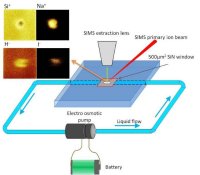Atmospher Sci & Global Chg
Research Highlights
April 2012
Triple Play for Liquid Probing
Technical advance allows researchers to watch liquid surfaces interact

A schematic showing the micrometer-sized “window” where the vacuum interface is probed by ToF-SIMS and images of the liquid surface. Enlarge Image
Results: An ingenious technique, developed by scientists at Pacific Northwest National Laboratory, enables real-time examination of molecular-scale interactions on liquid surfaces. This novel creation combines the manipulation of tiny amounts of fluids, called "microfluidics," and a partially open detection area for imaging the chemical physics of liquid in a vacuum. Their breakthrough portable sample holder enables direct probing of liquids suitable for multi-instrument, vacuum-based imaging using a single sample. The benefits have been demonstrated in high spatial resolution surface microscopy and mass spectrometry instruments.
"We needed to probe a stable liquid surface—a flowing liquid—in various instruments," said PNNL scientist Dr. Xiao-Ying Yu, a physical chemist and lead author on one of three research articles on this technique. "We created one sample holder, a multi-modal technique that offers perspectives of various chemical compositions, spatial resolutions, and morphologies. This provides a molecular makeup on water-based surfaces that has not been done before."
Why It Matters: Chemical interactions happen at surfaces. Whether it is interactions in a fuel cell or in droplets that form clouds, materials meet at their surfaces. This means understanding what happens at the moment when water, the most common liquid, meets with other surfaces. This knowledge could change how basic energy research, climate study, and biological investigation are conducted. Their approach allows scientists to move a single prepared sample from one probing instrument to the next and could provide a multifaceted view of interfacial phenomena as well as significantly reduce research time and costs in multiple areas of science.
Methods: A multi-disciplinary team of researchers at PNNL set out to improve the analysis tool set for probing liquid surfaces in vacuum. Their research validates current theoretical understanding of aqueous surface interactions at the molecular level.
The team designed an ingenious flow cell that allows liquid surface probing in situ using vacuum-based surface techniques, such as scanning electron microscopy (SEM) and time-of-flight secondary ion mass spectrometry (ToF-SIMS). The researchers created a microfluidic module compatible with vacuum that allows a micrometer-sized diameter aperture into the flow cell. Surface tension holds the liquid within the detection area. They directly exposed the surface to vacuum, which had not been done before in flow cells.
The technique is a counterpart to an established liquid microjet method. However, the new system has the added benefit of direct measurement on the liquid surface. This technique also tackles a common concern in vacuum: how to prevent liquid cooling. The researchers determined that controlling the aperture size of the "window" within vacuum would regulate the cooling and assure that the surface remained liquid. In additional studies, they used SEM to analyze the flow cell sample which offered an examination of the elemental composition. ToF-SIMS provided a high-resolution look at the smaller, molecular-level composition.
Access to the EMSL user facility was instrumental in the microfluidic flow cell's fabrication, which was done in EMSL's microfabrication capability, and for readily using both the ToF-SIMS and SEM instruments in analyses.
"We are providing a more complete picture," Yu said. "This technique is a technical breakthrough in showing what is happening at interfaces. The power of this fundamental research is that with some adaptations, it can apply to many different interfaces in multiple instruments."
What's Next? Expanding the possibilities for fundamental research liquid interfaces, this imaging technique has the potential for far-reaching impact in multiple scientific disciplines, including interfaces in atmospheric sciences, catalysis, and energy storage materials.
The design and technique for the portable flow cell already has been submitted for a patent, and PNNL scientists are continuing to explore potential industry technology transfer and licensing applications.
Acknowledgments: The research was supported by the U.S. Department of Energy Chemical Sciences, Geosciences, and Biosciences Division for Basic Energy Sciences. The research was performed using EMSL, a national scientific user facility sponsored by DOE's Office of Biological and Environmental Research and located at PNNL. The research was performed by Drs.Xiao-Ying Yu, Li Yang, Zihua Zhu, James P. Cowin (retired), Theva Thevuthasan, and Martin J. Iedema at PNNL.
References: Yu X-Y, L Yang, Z Zhu, JP Cowin, and MJ Iedema. 2011. "Probing Aqueous Surfaces by TOF-SIMS." Spectroscopy: Solutions for Materials Analysis, Special Issue: Current Trends in Mass Spectrometry 25(10):34-38.
Yang L, X-Y Yu, Z Zhu, S Thevuthasan, and JP Cowin. 2011. "Making a Hybrid Microfluidic Platform Compatible for In Situ Imaging by Vacuum-Based Techniques." Journal of Vacuum Science & Technology A 29(6):061101. DOI:10.1116/1.3654147.
Yang L, X-Y Yu, Z Zhu, MJ Iedema, and JP Cowin. 2011. "Probing Liquid Surfaces under Vacuum using SEM and ToF-SIMS." Lab on a Chip 11(15):2481-2484. DOI:10.1039/C0LC00676A.
